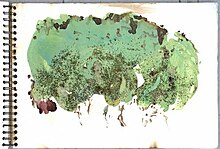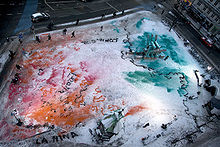Emmanuel Flipo
Emmanuel Flipo (born August 1, 1958 in Agen , France ) is a French artist.
Life
Flipo attended the Ecole des Beaux-Arts in Toulouse in 1977 . From 1978 to 1982 he studied at the Ecole des Arts Décoratifs in Nice . From 1983 to 1993 he ran his own drawing school in Pézenas . Flipo took his first trip to New York in 1993 , where he met the gallery owner André Emmerich . Until 2003, Flipo returned to New York regularly to work. In 1997 he founded the artist movement la colectiva . In 2001, Flipo was instrumental in founding the Stop Art center for contemporary art in San José , California . In 2003, Emmanuel Flipo finally founded L'usine 64 in Montreuil (Seine-Saint-Denis) in a former factory he had converted and designed his studio there. Since then he has lived and worked in his studio in Pézenas in the summer and in Usine 64 in the winter.
plant
Etude topographique
The "Etude topographique" is the most comprehensive series by Emmanuel Flipo. It consists of watercolors and collages that he creates from found materials such as old drawing pads that others have thrown away.
Influenced by Asian calligraphy and Russian constructivism , Flipo developed topographic studies. The structure of the work was reflected in nature, abstracted on two dimensions. This is how the unique combinations between surfaces, fine lines and structures as well as open spaces were created. The artist calls his formal language Figuration particulière et moléculaire .
The reference to the structures of nature, the focus on what was seen and the abstraction of the human being from the work led to the artist completely withdrawing himself as a person and serving much more as a "medium" for the creation of the Etude topography , according to the ideas the French artist group Supports / Surfaces , who put the work itself at the center of their interest. Many combinations of shapes that Flipo applied to the specially prepared carrier sheets with found colors, dried plant leaves, bird feathers, wallpaper remnants, etc., creating remarkable surface structures and spaces, often appear by chance.
Collages
The mostly large-format collages by Emmanuel Flipo are closely related to the Etude Topographique. In this work block, Flipo combined the technique of collage with painting and drawing . In these works, too, Flipo refers to the French artist group Support / Surfaces. a. deal with the democratization of the found or purchased materials of the creative process and the final work. Without exception, Flipo used found materials for his collages, e.g. B. linoleum , cardboard or wooden boards found on the street or at collection points , or paint from the special material collection, coffee and plant parts from his garden.
This unique combination of the different materials created a multi-layered, tension-charged surface structure that bears the history and erosion of the individual materials and, as a work of art, is still subject to the natural erosion process. This change is part of the work and indicates Flipo's confrontation with the life cycle, beginning and end and beginning again.
Performances
Emmanuel Flipo realized his first performance with the title El Nino in 1996 on 53rd Street in New York. She dealt with geopolitics in connection with global warming , which was discussed more and more frequently in the media . In these performances, Flipo became part of the work of art, the process of creation came to the fore. As with the work of Joseph Beuys , whose work (in particular his idea of the Gesamtkunstwerk and the relationship between art and life) Flipo dealt intensively with, the performance remained the documentation for those who were not present.
On the occasion of COP 15 in Copenhagen in 2009, Emmanuel Flipo realized one of his ephemeral cards. He called this performance La Niña - in the continuation of his first performance El Niño in 1996. Using loose pigments and with the help of the wind, the artist drew a gigantic map on a public square in Copenhagen to inform the audience of the threatening effects of current environmental policy also to draw attention to the behavior of each individual.
On the occasion of most of the performances, video films were made, which together with the "relics" were declared works of art. Photo material from well-known artists such as Igor Vishnyakov or Jonathan Abbou, whom Flipo had invited to document his performances, also formed part of the final work. The conscious involvement or exclusion of the audience, the use of music, fire, water and earth continued Flipo's preoccupation with the eternal cycle and the network of relationships and thus created spaces beyond what was seen.
Exhibitions (selection)
Solo exhibitions
- 1988: Galerie Hélène Trintignan, Montpellier
- 1992: CRDC, Rosny-sur-Seine
- 1999: Rodriguez Degranier Gallery, New York
- 2002: Center d'Art “Stop Art”, San José, California
- 2007: Usine 64, Montreuil
- 2010: Squat Rivoli, Paris / France
Group exhibitions
- 1986: Galerie Hélène Trintignan, Montpellier
- 1987–1990: Artist at the Blackman Havey Gallery, London
- 1988: Galerie Clavé, Guadalajara, Mexico
- 2009: Gallery / Atelier / Résidence Jonathan Abbou, Montreuil
- 2009: “Le Carré dans l'Art”, Galerie Blumann, Paris / France
Catalogs
- "Les Gens du Picaro - Portrait d'Emmanuel Flipo", 2008, catalog
- "Akdéniz (mer claire en turc," Méditerranßée) ", Pézenas with texts by Loic Lantoine and pictures by, among others, Igor Visnyakov
- "Emmanuel Flipo - La Mémoire des Vivants et des Morts", text by André-Pierre Arnal, 1992–1993
- "Erosion", Rodriguez Degranier Gallery, catalog
- "Emmanuel Flipo", with a text by Dimitry Nesterov, catalog
Web links
- emmanuelflipo.com , website of the artist
- hyperrealart.com , images of the artist's work
- art-regard.com , article about the artist (French)
- thespartandaily.com of February 24, 2003 , Huong C. Pham: A Colorful Statement - Political message conveyed through unusual medium (English)
- artween.com , pictures of the artist's work and exhibition views
Individual evidence
- ↑ emmanuelflipo.com ( Memento of the original of July 10, 2011 in the Internet Archive ) Info: The archive link was automatically inserted and not yet checked. Please check the original and archive link according to the instructions and then remove this notice. (PDF; 81 kB), accessed April 2009
- ^ "Les Gens du Picaro - Portrait d'Emmanuel Flipo", 2008, catalog
- ^ "Emmanuel Flipo", with a text by Dimitry Nesterov, catalog
- ^ Ingrid de Garnier in: "erosions", Rodriguez Degranier Gallery, catalog
- ↑ emmanuelflipo.com ( Memento of the original of July 10, 2011 in the Internet Archive ) Info: The archive link was automatically inserted and not yet checked. Please check the original and archive link according to the instructions and then remove this notice. (PDF; 81 kB), accessed April 2009
- ↑ Archived copy ( memento of the original from March 3, 2016 in the Internet Archive ) Info: The archive link was inserted automatically and has not yet been checked. Please check the original and archive link according to the instructions and then remove this notice.
- ↑ http://www.midilibre.com/articles/2010/02/01/VILLAGES-L-39-oeuvre-ephemere-de-l-39-artiste-Emmanuel-Flipo-a-Copenhague-1094095.php5 ( page no longer available , search in web archives ) Info: The link was automatically marked as defective. Please check the link according to the instructions and then remove this notice.
- ^ Artnet.de , accessed April 2009
- ↑ jonathanabbou.free.fr , accessed April 2009
- ^ "Emmanuel Flipo", with a text by Dimitry Nesterov, catalog
| personal data | |
|---|---|
| SURNAME | Flipo, Emmanuel |
| BRIEF DESCRIPTION | French artist |
| DATE OF BIRTH | August 1, 1958 |
| PLACE OF BIRTH | Agen , France |



